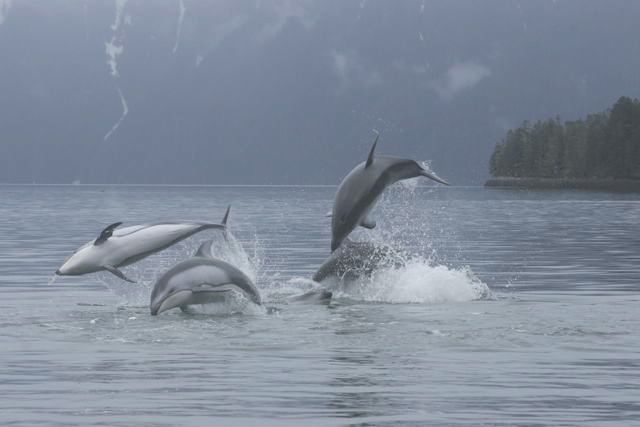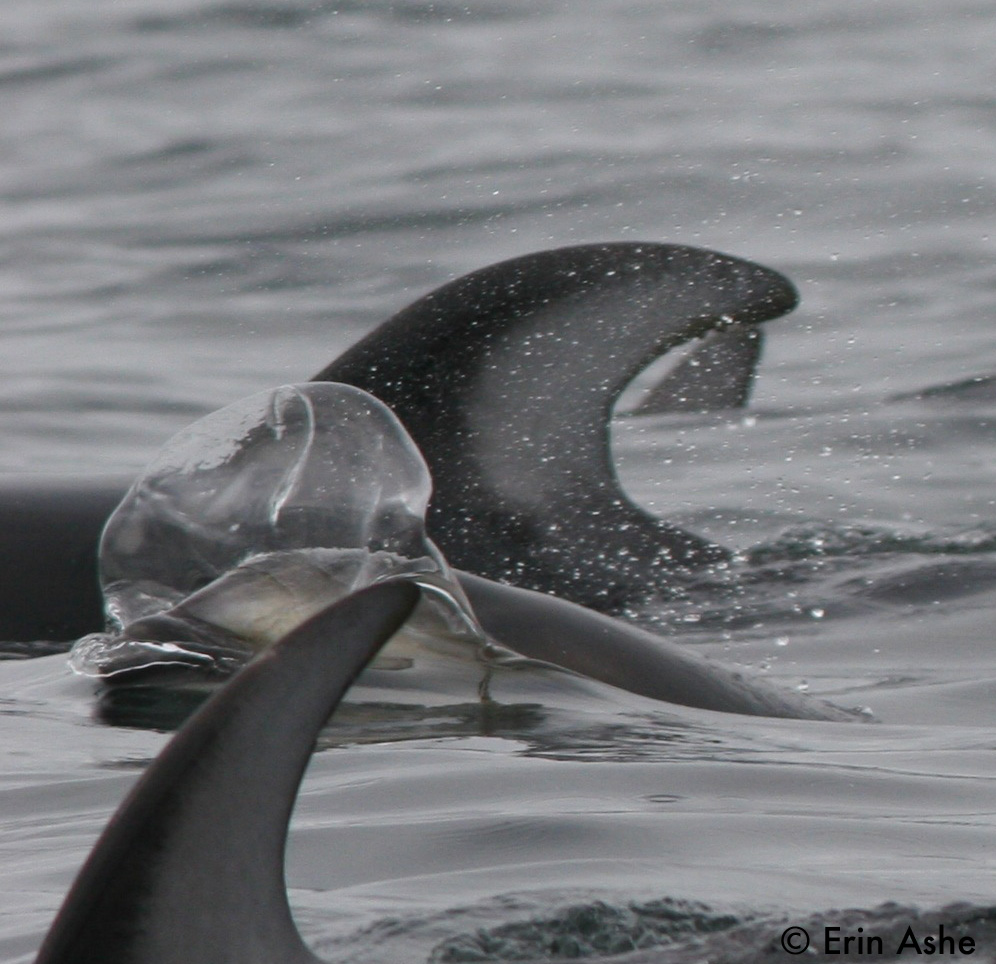
In the summer, you can you usually find Rob, Wishart (the dog) and me doing field work in our little boat with whales and dolphins in British Columbia, Canada. This year’s different.
We’re in a new country. Scotland. I’m finishing my PhD on dolphin ecology and Rob is in the middle of his Marie Curie Research Fellowship (researching ocean noise), both at the University of St Andrews.
This is the first time in over a decade that we are away from the Pacific Northwest and sitting a summer out. There’s no denying it: we are homesick. Wishart’s actually homestick (there is way less driftwood on these beaches than at home!).
We find ourselves fighting the urge to pack our camera equipment, binoculars, field notes and dog biscuits into the boat. We’re restless. We are constantly gazing out into the waves, hoping for a marine mammal to emerge.

Wilderness was required. We needed to increase the probability of a dolphin sighting. A road trip was in order. So, we packed up and headed to the Highlands, to the stunning Isle of Skye to visit a friend, Deirdre. (Truth is, we needed a doctor’s signature on a form, but any excuse for a road trip. We also miss long Canadian drives.) So we did what you do before any pilot field study: we asked around for traditional ecological knowledge. Fortunately, here at the world renowned Sea Mammal Research Unit, you don’t need to go far to find an expert on sea mammals. Our good friend and colleague, Lindsay Wilson, conducts amazing research on seals and their diet all over Scotland. Lindsay handed us a map, pointed out some hotspots, and away we went!
Wishart is an incredible dolphin-spotter. But this trip was going to be exclusively shore-based. However, he did mange to spot some wildlife for us along the way.
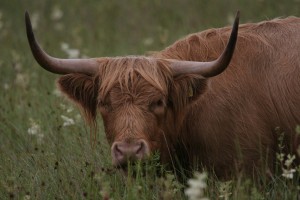
When we reached our destination the first night, we spotted a pod of about 20 common dolphins swimming past our hotel as we parked the car! Mission accomplished. Unless we start seeing bottlenose dolphins in St Andrews Bay, that glimpse may have to tide us over until the fall, when Rob and I will be presenting our work at the Salish Sea Ecosystem Conference in Vancouver. Rob will present his work on ocean noise, killer whales and salmon. I’ll present on dolphins. We will travel to the conference thanks to generous donations of frequent flyer miles to our charitable pooling account with Aeroplan. If we can raise enough cash to put fuel in our boat, we will also be able to spend two weeks conducting conservation-minded research on Pacific white-sided dolphins. Learn more about our dolphin study here, and if you’re interested, you can help support our dolphin field work here. Thanks very much!
Happy summer,
Erin +Rob
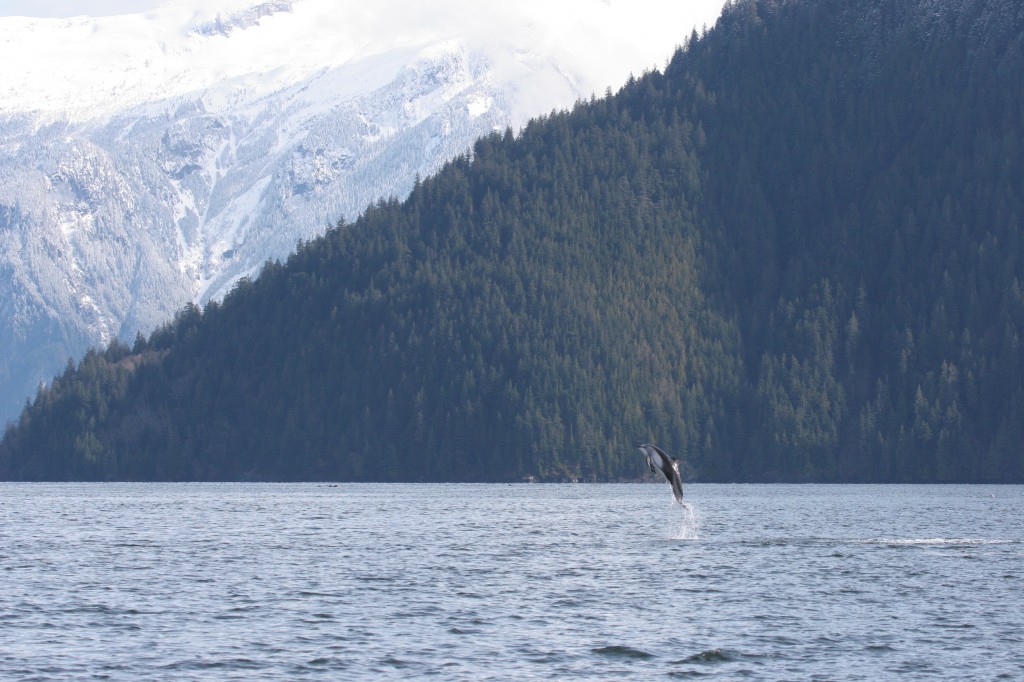
It’s that time of year again. Pacific white-sided are making appearances in the waters throughout the Pacific Northwest. Last month, Knight Inlet, BC was bursting with Pacific white-sided dolphins and we were there to collect ID photographs, acoustic recordings (Click here to listen) and prey samples.
Soon after our Knight Inlet trip ended, our colleague, Dr Andrew Wright, photographed a group of dolphins in Howe Sound, between Vancouver and Bowen Island! He took some beautiful photographs, and a few of the individuals bear distinctive markings. Now, thanks to the support from the SeaDoc Society, we are doing the painstaking work of comparing his few mug shots to our catalogue, to see if there are any matches between dolphins in the Broughton Archipelago and those using the Salish Sea. In fact, our partnership with SeaDoc has inspired us to take a transboundary look at our cetacean conservation work more generally.
Which reminds us, if you spot any dolphins, we are very grateful for any opportunistic photographs of dolphin dorsal fins. This is what a dolphin ID shot looks like:
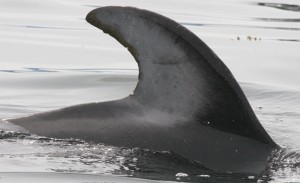
but, please, only try this at home if you have a really long lens. Remember that the “Be Whale Wise Guidelines” also apply to dolphins, so please remember to remain at least 100 meters/yards away. Thanks!
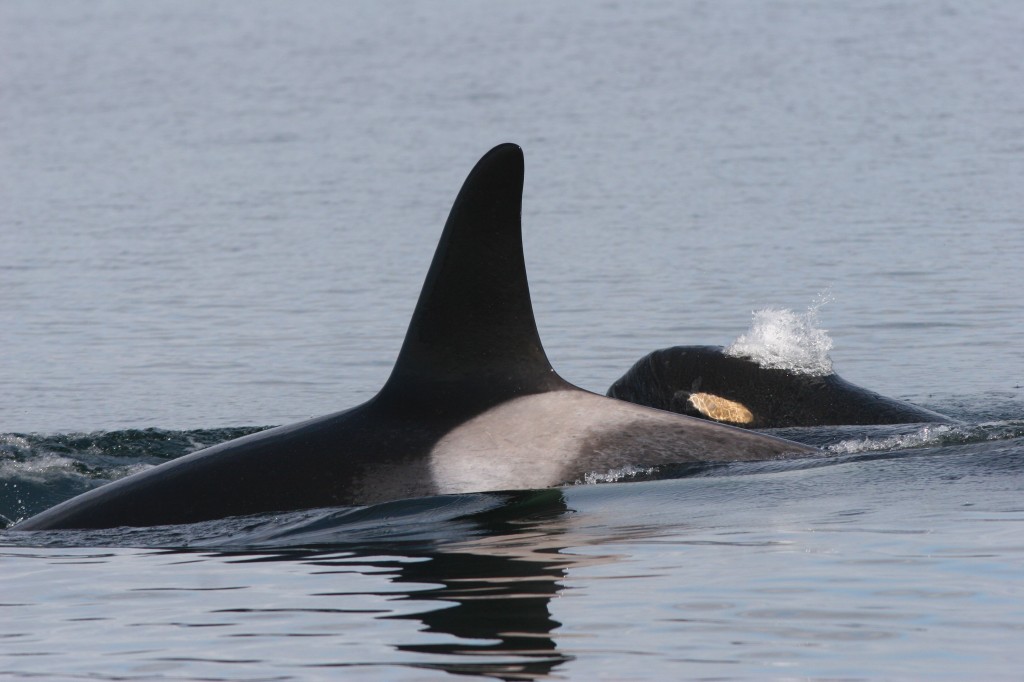
I’m not a mom (yet), but being in the field with whales and dolphins for my PhD research is making me think a lot lately about motherhood. The killer whales (orcas) that we study stay with their mothers their entire lives: they live in a matrifocal society. That’s rare. Sure, when the daughters grow up and have whale babies of their own, they often travel in their smaller family groups and spend days apart, but what’s unusual is that even sons stay with their mums their entire lives. That’s unheard-of in any other mammalian society. We’re not sure what advantage this social structure offers to killer whales. Maybe mothers pass on critical information, and serve as archives of lessons learned through time on where to find salmon in lean years and where the best rubbing beaches are.
This week we attended a fantastic lecture by Jane Goodall here in St Andrews. The science was interesting, but we were most struck by the story of how Jane Goodall became Jane Goodall. As Dr. Goodall recounted her incredible story of becoming first a primatologist and then a force of nature, she attributes her path and success to the support of her mother (we do too!). Chimpanzees, Dr. Goodall reminded us, also have societies that rely on mothers to teach offspring, and nurture and protect young chimps.
Moms know stuff. In one ‘green mommy blog’, Eco Child’s Play , the author points out the possible dangers to your baby (decreased IQ, increase in attention-deficit disorder, cancer, endocrine disruption) from using products loaded with chemical flame retardants. These contaminants are not good for human babies and, as it turns out, not good for killer whale babies either. Our colleague, Dr. Peter Ross has found very high levels flame retardant chemicals in the blubber of killer whales.
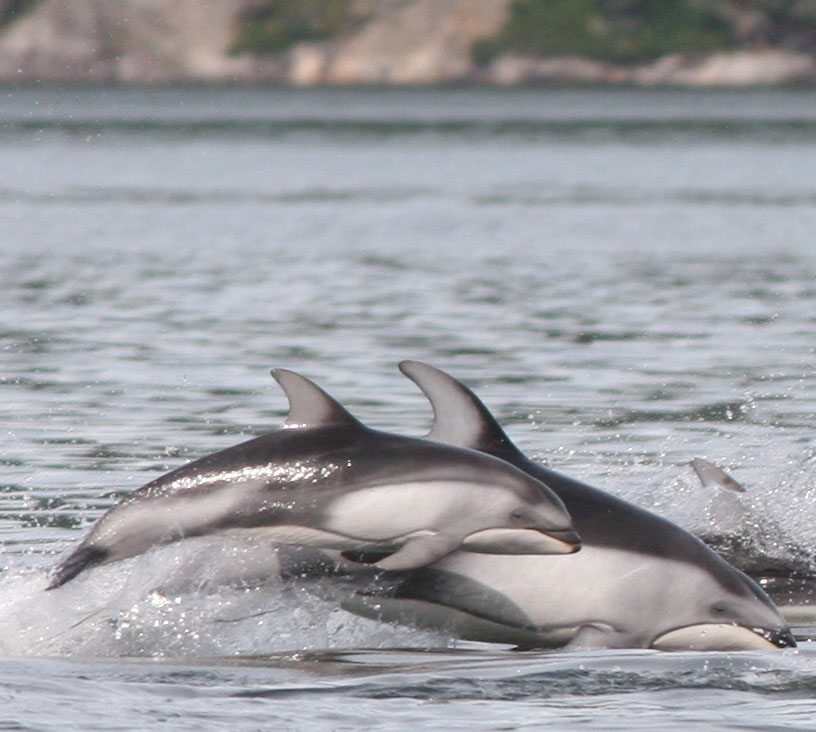
Alexandra Morton began to notice Pacific white-sided dolphins in her study area in the late 1980’s. If you open any guidebook, they’ll tell you that Pacific white-sided dolphins “belong” way offshore, but after a decades-long absence, these dolphins came into the inlets of mainland BC in groups of hundreds. The odd thing was, there were no babies. Just adult dolphins. Then, in 1995, the first young dolphins began to appear. Were other dolphins scoping out peripheral, new habitat before letting moms and babies know that it was safe? These days, I see quite a number of mothers and babies. Even newborns. In fact, these dolphins may actually be giving birth in the inlets right in our neighborhood. That’s quite a surprise for a species perceived as a resident of the high seas. This is the phenomenon I want to study next.
In the meantime, knowing this makes me want to protect dolphin habitat from noise, nets, pollution and plastic. Are these my maternal instincts kicking in?
This is a big week for the planet. Earth Day and the one-year anniversary of the BP/Deepwater Horizon oil spill in the Gulf of Mexico. It will take years to assess the damage from the Gulf spill economically, societally and ecologically. A recent paper in Conservation Letters led by Oceans Initiative’s Dr Rob Williams with the help of many co-authors, suggests that the dead dolphins washing up on the beach are really just the tip of the iceberg. The team evaluated historic carcass recovery rates in two ways. One indicated that there could be as many as 50 dolphins that were scavenged, drifted offshore or sank to the bottom of the ocean for every dolphin carcass recovered on the beaches. The other method yielded an even scarier ratio of 250:1.
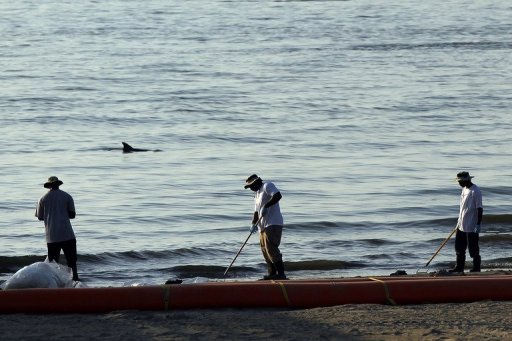
Dead whales and dolphins on beaches represent only the damage we can see. Killer whale biologist and director of the North Gulf Oceanic Society, Craig Matkin, notes that a genetically distinct pod of killer whales, the AT1pod, exposed to oil from the Exxon Valdez oil spill, have yet to reproduce 22 years later. Since no calves have been born, the unique killer whale pod will be lost. However grim the statistics, scientists are able to make these calculations thanks to years of careful research on whale and dolphin populations. Closer to home, imagine how warped our perception of killer whale populations in BC and Washington would be if all the information we had available came from the occasional carcass that washes ashore, instead of conducting annual counts of the entire population, which is what our colleagues at Fisheries and Oceans Canada and the Center for Whale Research do. There is simply no substitute for the hands-on, hard work of long-term monitoring of cetacean populations.
But many cetacean populations are still under the radar. You may be surprised to find that for many whale and dolphin species, we still lack basic information on how many there are and how healthy the populations are. In 2004, we partnered with Raincoast Conservation to design and conduct systematic surveys to estimate abundance of 6 cetacean species in BC, and we’ve seen first-hand that it is possible to contribute important baseline science while working on a modest budget.
At Oceans Initiative, our aim is to identify data gaps and make it a priority to fill the ones we can afford to (and are most qualified) to fill. Earth Day prompts us to reflect on the contribution we are making to marine research and conservation, but our goal, every day, is to identify modest contributions that we can make to improve the quantity and quality of science available to make decisions that sustain the BC marine environment.
Our recent dolphin ‘spring fling’ {AKA Dolphin-Palooza 2011} is a good example. With 10 days and a lot of help from our friends and neighbours, we collected gigabytes of photo-identification and acoustic data on Pacific white-sided dolphins in BC, at the extreme south end of the Great Bear Rainforest. Because we are building on Alexandra Morton’s 20 years’ worth of meticulous photographs and observations, we expect that soon we will have a good estimate of abundance, survival and a glimpse into Pacific white-sided dolphin population structure. These important pieces of information form the basis on which sound management decisions can be made. The kind of baseline information we are collecting is essential, whether we are dealing with day-to-day conservation and management decisions or (heaven forbid) assessing damage and supporting recovery if a catastrophe on the scale of the BP oil spill should ever occur in Pacific Northwest waters. The science we do is not the most glamourous kind of field work, but it is necessary. And we love what we do.
